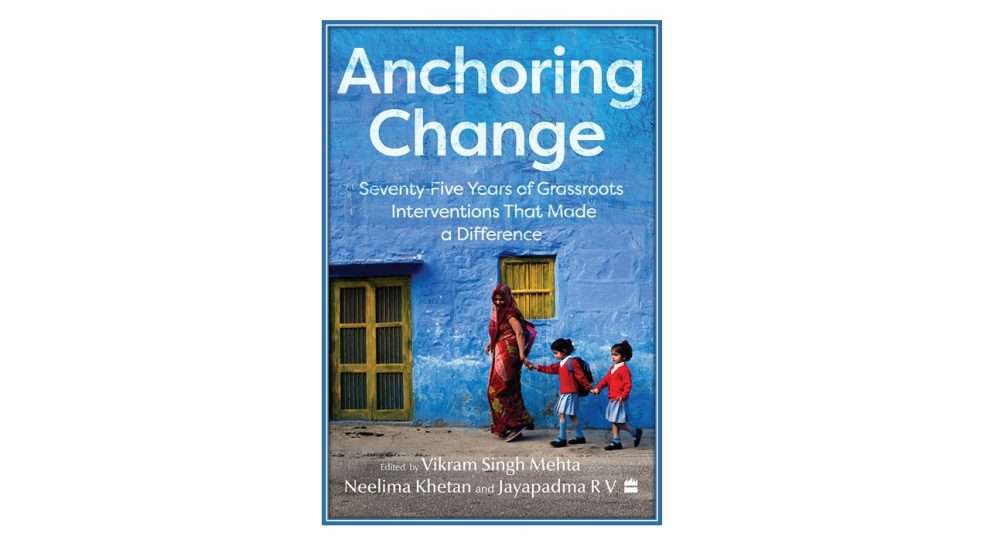Vikram Singh Mehta, Neelima Khetan and Jayapadma RV (Editors) 2022
Publisher: HarperCollins India
Language: English
Pages: 361
ISBN: 978-93-5629-187-4
Price: INR 699 (Paperback)
It is rightly said that context drives development and over the 75 years of India’s independence the context has evolved tremendously both in terms of the social development challenges that the country has faced and also the development responses to them. The past 20 years or so have been particularly fast paced on both these counts.
The book Anchoring Change does two things. At the outset it introduces readers to the numerous social challenges and attempts to address them through deep and thoughtful interventions, but more importantly it paints a picture of the evolving and diverse context of India over the last five decades or so. The chronology of grassroots interventions –from the initiation of MYRADA in Karnataka in 1968 to JEEViKA in Bihar in 2006 – gives a sense of how the development responses evolved in answer to the diverse as well as changing social development context of India.
The book uncovers 24 narrations of grassroots interventions by those who have led or are leading these interventions, thus providing an insider account of the institutional journeys of these initiatives. These narrations are a combination of the journeys, experiences and insights of civil society organizations, social enterprises, corporate programmes and initiatives led by the government. The decision by the editors to ‘let these stories unfold as the authors so wished’ does bring out the diversity of language, perspectives, and the context in which these narrations have been placed, and adds up to provide a non-linear and heterogeneous view to what these interventions have been to readers.
The book starts with the Synthesis from Vikram Singh Mehta, which in itself tries to depict the essence of the book and the intentions behind it. It provides an overall view of the social development context of the country by categorizing it into four temporal quartiles starting from ‘early decades after independence’ to the last section on ‘innovations in the new millennium’.
What is interesting for the reader, however, is the unfolding of the fact that in different parts of the country development responses to complex social problems had different temporal trajectories. While MYRADA’s Credit Management Groups (CMGs) recognized and responded to the inequalities reaffirmed by caste, tradition and economic factors within the Primary Agricultural Cooperative Societies (PACS) in 1968, JEEViKA in Bihar kept Social Inclusion based on identities of caste and being tribal as an important and integral element – thus recognizing that even three to four decades later major developmental challenges still exist in similar forms in different parts of the country.
As the 24 journeys are narrated by different protagonists the writing styles are diverse and different. While the reader gets an insight into ‘what development challenge or problem’ each of these interventions try to address and ‘what was done’ for it, they also present the organizational churning, dilemmas and reflections that addressing these challenges and organizational evolutions posed, over time.
Questions and reflections such as: Who does ‘development’? and Questions without easy answers? from Seva Mandir (https://www.sevamandir.org/) or Eklavya’s (https://www.eklavya.in/ ) realization that the path for macro dissemination had to be different from the path taken by the micro experiments, present an opportunity for readers to look at and reflect on their work more closely. The need to see these is even more critical if they are interacting with social development issues or are directly responsible for carrying out development work.
The book is likely to find a diverse set of readers but there might be a predominant section of readers who can relate to the context more closely having worked on social problems and having crossed paths with these organisations and interventions at some point. To them the book might bring a completeness to the narrative at it provides the context in which these organisations and their interventions were initiated, and how they have evolved over time. They will be at home with the language, expressions, the reflective questions as well as self-critique, and stand to gain much from the depth these insights have brought.
A reader uninitiated to the social development universe, however, might struggle to catch up with a world which is not overtly visible in day-to-day transactions of life in urban spaces, the struggles and heterogenous dilemmas that social development practitioners and leaders face on a regular basis, and how social, gender and economic identities have kept a large section of India on the margins and are among the causal factors for deprivation and poverty.
The language for both these sets of readers, however, is easy to understand and the writing lucid in almost all the narrations keeping alive the interest to know more. The lengths of the narratives also help in ensuring that they are quick reads, and each narrative can be read in a standalone fashion.
What sets some of the narratives apart from others is the ability of the protagonists to weave anecdotes, personal experiences and human stories in the narratives, thus giving a visual feel to the narratives and making the reading even more engaging. Whether it is the observation that salt was being stored in an empty eggshell in Andhra Pradesh that triggered the realization within Goonj of the utter deprivation of the poor who did not even have household utensils. Or, of how people face their lives in the wake of a natural disaster; or the story of Sabina Khatun in Bihar that underlines the ‘silent revolution’ that JEEViKA didis are bringing about; or the story of Mahendran of Tamil Nadu which gives an insight into the history and criticality of the nutritious meal programme of the state in Tamil Nadu. All these have the capacity to engage the readers and establish the tenets of the intervention without going into complex and technical/theoretical structures and prose which may at times lead to monotony for the uninitiated readers.
For those who are starting their foray into the world of social development this book also has the potential to offer much knowledge that they can learn and adopt from the core principles and lessons that most of these 24 narratives have distilled for them. The diversity among the narratives in approaching these sections and at times the contradictions that different models might pose in the minds of the readers has the potential to trigger individual agitation as well as articulation of personal dilemmas in these overwhelming times.
Belonging as such to the social development field of practice my familiarity with many of the organisations has helped me realize the humility with which many of these leaders or protagonists approach the narrative of success, transformation and impact. There is always measured caution, and probably rightly so, in being the claimant of change and transformation and the same is reflected in many of these narratives. As a reader I yearned for some of the narrators to shed that modesty and be more direct in their narrations as they have the potential to establish a larger cause for continued deep and complex social development action by a diverse set of actors.
Finally, there is a lot to be discovered in terms of the development lexicon and the book provides structure to the practice and thoughts that many of the readers might be having whether it be ‘Arakunomics’, ‘urgent patience’, ‘Auto-money for Autonomy’ or ‘Village Cohesion Index’. These are better left for the readers to discover by themselves.
This book will definitely be valued by a cross-section of readers who want to understand the complexities of social challenges in India and how impactful solutions have been found for them through deep social action. I would definitely recommend it to individuals engaged in social development practice and policy influencing, those responsible for designing and executing development programmes, and also to individuals leading social action organisations. It must be made required reading for students of rural development/management, social work, agriculture and agriculture extension, and any other discipline that can contribute towards addressing some of these social challenges persisting in India.
Avinav Kumar
 Avinav Kumar is a social development practitioner and has worked in different parts of India and has contributed to several social action initiatives in the past 22 years. A postgraduate from Indian Institute of Forest Management (IIFM), Bhopal, he presently leads programmes with the Partnering Hope Into Action (PHIA) Foundation (https://phia.org.in/) and lives in Bhopal. (avinav.kumar@gmail.com)
Avinav Kumar is a social development practitioner and has worked in different parts of India and has contributed to several social action initiatives in the past 22 years. A postgraduate from Indian Institute of Forest Management (IIFM), Bhopal, he presently leads programmes with the Partnering Hope Into Action (PHIA) Foundation (https://phia.org.in/) and lives in Bhopal. (avinav.kumar@gmail.com)





“I personally feel that we are weak in relating agricultural development with social development. We extension scientists focus and rely mostly on increasing agricultural production with little concern for social development. By reading books like this, which focus on various developmental approaches in different contexts, will certainly enrich the extension scientists in addressing the social development issues in a better way.
This book “ Anchoring change – Seventy-five years of grass roots intervention that made a difference“ appears to be an interesting one and I think there is a lot for the extension scientists to learn from 24 different approaches adopted by various institutions to address social development issues in different parts of the country. Thanks to Avinav Kumar for lucid book review and also to AESA for making it accessible to us”.